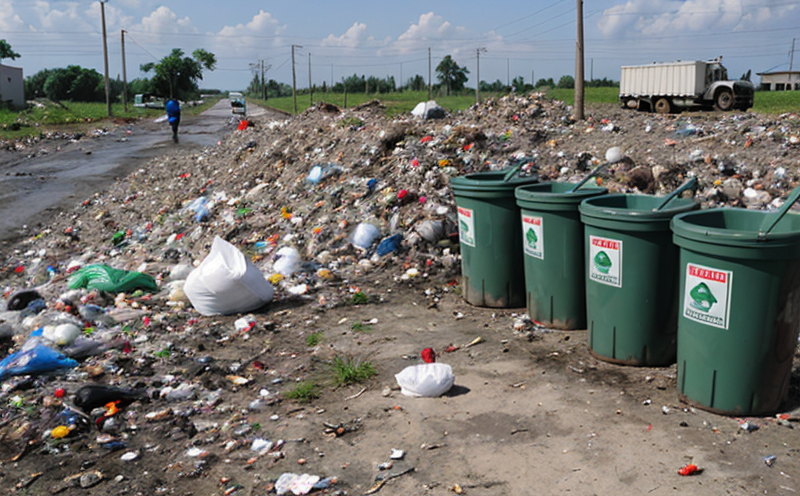EN 13657 Acid Digestion of Solid Waste for Metals Test
The EN 13657 test method is a standard procedure widely used in the environmental testing sector to determine the metal content in solid waste materials. This method involves digesting solid waste samples with concentrated acids, typically nitric and hydrochloric, followed by analysis of the resulting solution for metals using appropriate analytical techniques such as inductively coupled plasma optical emission spectrometry (ICP-OES) or atomic absorption spectroscopy (AAS).
The primary purpose of this test is to identify trace elements present in solid waste, which can be critical information for waste management practices and environmental protection policies. The accuracy and reliability of the results are paramount, as they influence decisions regarding recycling processes, landfill operations, and compliance with regulatory requirements.
Compliance with EN 13657 ensures that laboratories adhere to internationally recognized standards, providing stakeholders with confidence in the integrity and consistency of test outcomes. This method is particularly relevant for sectors dealing with industrial by-products, municipal solid waste, construction debris, and other types of solid waste materials.
The digestion process involves several steps:
- Sample preparation: The solid waste sample must be finely ground to ensure even digestion.
- Digestion: The sample is placed in a digestion vessel with concentrated acids. This step may require heating and stirring for optimal dissolution of the sample.
- Filtration: After digestion, the solution is filtered to remove undigested solids.
After filtration, the solution undergoes further analysis using precise analytical instruments. The accuracy of these analyses directly impacts the reliability of the test results. It is crucial that all steps are meticulously followed and documented to ensure compliance with EN 13657.
The acceptance criteria for this method are based on achieving a certain level of precision and accuracy in metal content determination. Laboratories must demonstrate proficiency through inter-laboratory comparisons, where results from different laboratories should be within specified limits set by the standard.
Understanding the context of waste management is essential when applying EN 13657. This test helps in identifying valuable metals that can be reclaimed and reused, thereby reducing environmental impact and resource consumption. For instance, in recycling processes, knowing which metals are present allows for more efficient separation techniques to be employed.
By adhering to this standard, laboratories can ensure they meet the demands of regulatory bodies and provide reliable data that supports sustainable waste management practices.
Benefits
The implementation of the EN 13657 test method offers several advantages:
- Compliance with international standards, ensuring accuracy and reliability in metal content analysis.
- Support for informed decision-making regarding solid waste management practices.
- Facilitation of recycling processes by identifying valuable metals present in waste materials.
- Achieving regulatory compliance for businesses operating within the environmental sector.
The precision and accuracy provided by this method enhance trust among stakeholders, including regulatory bodies, industrial clients, and consumers. It also supports research and development efforts aimed at improving waste management techniques and technologies.
Competitive Advantage and Market Impact
Laboratories that offer the EN 13657 test method can gain a significant competitive edge in several ways:
- By demonstrating compliance with international standards, laboratories can build credibility and trust with clients.
- Offering this service allows businesses to stay ahead of regulatory changes and market trends related to waste management.
- The ability to provide accurate and reliable data supports the development of new products and processes in the environmental sector.
In terms of market impact, laboratories that excel in offering EN 13657 testing can attract a broader client base, including government agencies, private waste management companies, and research institutions. This service can also contribute to reducing overall environmental impact by facilitating more efficient recycling processes.
Use Cases and Application Examples
| Use Case | Description |
|---|---|
| Industrial Waste Recycling | Determining the metal content in industrial by-products to identify valuable metals for recycling. |
| Municipal Solid Waste Management | Assessing the composition of municipal solid waste to inform landfill operations and recycling strategies. |
| Construction Debris Analysis | Evaluating the metal content in construction debris for potential reuse or disposal decisions. |
In a case study, a municipal waste management facility used EN 13657 to analyze its daily waste streams. The results helped them optimize their recycling programs by identifying specific metals that could be extracted and reused in manufacturing processes.
Another example is an industrial company using the test method to comply with regulatory requirements for hazardous waste disposal. By accurately determining metal content, they ensured safe handling and disposal practices were followed.
These use cases demonstrate how the EN 13657 acid digestion method can be effectively applied in various sectors to achieve sustainable waste management goals.





